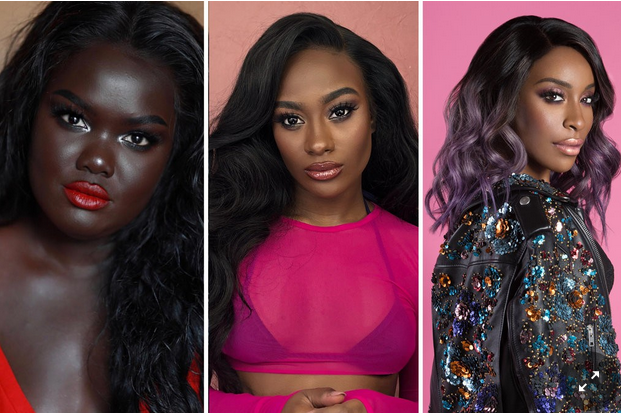Women are not born knowing how to do a flawless cat eye or a shadowy, smoky eye, so they often turn to makeup tutorials on YouTube. A search for “smoky eye” pulls up endless videos showing how to perfectly blend eye shadows to achieve the look.
Simple.
But what if you had dark skin and most of the videos showed lighter-skinned women applying hues that would make you look as if you had a black eye? What if you couldn’t relate to these women, because you couldn’t see yourself in them?
The answer to that is also simple: You make your own YouTube channel.
That is what Jackie Aina, 31, Monica Veloz, 26, and Nyma Tang, 27, did. The three women collectively have nearly four million YouTube subscribers, with Ms. Aina alone having over two million.
The women, all self-taught, turn on their cameras at home, and show us how to put on foundation, apply lashes and highlight our cheekbones, step by step. They teach us what tools to use and which hair products work.
“I think everyone looks for someone that looks like them,” Ms. Tang said. “I was definitely looking for that, especially on YouTube, and it was hard to find tutorials on products for women with deeper skin.”
The beauty bloggers provide darker-skinned women with something they may not have a tutorial for: the confidence to wear bold colors, to stand up to haters, and, more important, to choose how they present themselves.
They try different makeup brands to show that they do work on dark skin or, of course, that they don’t. They teach women not to be afraid of color, like red lipstick, bright yellow eye shadow or holographic highlights.
Their videos and social media posts are finding an audience of black women who are ready to spend money on beauty products, studies show, but have few choices to pick from.
“Most beauty launches never worked for me,” Ms. Tang said.
“A lot of times they don’t want to take the time to make the product,” Ms. Veloz said, adding that beauty companies often treat women with darker skin as “an afterthought.”
The shade of the shade selection
Sometimes the women veer from the norm and make videos discussing race, their complexion and their background. They also poke fun at the hateful comments left under their videos.
But the bread and butter of a beauty blogger is to use a product and review it for her followers. Does it make her face greasy? Does it cover up scarring? Is it worth the price?
This task becomes increasingly difficult when there aren’t many products to choose from.
In a video filmed with friends, Ms. Veloz tries a newly launched foundation by Beauty Blender to find that none of the darker shades she received in a press kit fit her.
“I look gray, washed up,” Ms. Veloz exclaims. “I am very disappointed, because us Afro-Latinas, we are not in that box.”
If a beauty company doesn’t make a range of shades for dark-skinned women — or if its darker shades have orange bases that make women look like terra cotta pots — the ladies have no choice but to give an honest review.
“All I can do is judge you on the product,” Ms. Aina said.
Most makeup companies “are leaving women with higher pigment out of the conversation,” said Dr. Laporchia Davis, 30, an assistant professor at Morgan State University who wrote her thesis on the relationship between black women’s use of cosmetics, their attitudes and their identity.
“There are so many women with richer skin tones that most of these companies are overlooking,” Dr. Davis said.
‘The beauty industry is waking up’
For Jerrod Blandino, the co-founder and chief creative officer of Too Faced, it took a personal experience to realize that his brand might not be doing the most it could for women with darker complexions.
When he found out that a family member with deeper skin had to mix two products together to achieve proper foundation coverage, he asked Ms. Aina for help.
“I needed to learn what I didn’t know,” Mr. Blandino said, adding that it was important to “bring someone to my table who can teach me about the nuances of color and textures and help me and my company do this right.”
Too Faced released an expanded foundation line in collaboration with Ms. Aina earlier this year.
It’s not just about “creating shades for darker people,” Ms. Aina said, adding that when companies do not reach out to darker-skinned women to learn about their skin, both the companies and their customers miss out.


Several brands, including Iman Cosmetics, Fashion Fair, and MAC Cosmetics, have been focused on inclusivity for decades. MAC foundation became a go-to at fashion shows during the 1990s, said Jennifer Balbier, the company’s senior vice president of product development.
“Many models were of African descent and could not be matched properly, but when MAC foundation and concealer came to the scene, our shade range alleviated extensive shade mix and matching,” Ms. Balbier said.
Mr. Blandino, too, believes makeup companies are moving toward the ideal. “The beauty industry is waking up and understanding that people come in every shape, size, and color and we all matter,” he said.
He stressed that the industry must make inclusivity a lasting priority.
“This is not a moment, this is the future,” Mr. Blandino said. “It is very important that this doesn’t become a trend.”
In 2018, it is nearly impossible to have a conversation about beauty brands that cater to women of color without bringing up Fenty Beauty.
The year-old makeup line created by Rihanna began with 40 foundation shades, at least 10 of which are for dark-skinned women. The brand was praised for being inclusive to women of all shades and stores ran out of stock after the initial launch.
While these and other brands, including Pat McGrath Beauty Labs and Lancome, which has Lupita Nyong’o as a spokeswoman, put dark-skinned women front and center, less inclusive companies still take up the majority of shelf space at beauty and department stores.
[For more coverage of race, sign up here to have our Race/Related newsletter delivered weekly to your inbox.]
Sephora declined to discuss sales volume or provide data on foundation purchases, but a recent Nielsen study showed black women made up $151 million of the $679 million industry of nonessential luxury products.
If the demand and spending power is there, why are so few companies willing to make the products?
It’s simple, Ms. Tang said. Even today, “the default is whiter skin.”
Beauty bloggers have built up a rapport with women who feel that makeup brands have forgotten them. And they feel that it’s their responsibility to introduce these women to brands that see and understand them.
“What fuels me is all the dark-skinned women and girls that message me every day,” Ms. Tang said. “I don’t want anyone to feel like they are not beautiful enough.”
Published by NyTimes.com


